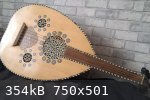Alyssia
Oud Admirer

Posts: 1
Registered: 10-6-2023
Member Is Offline
|
|
Tip to buy second hand oud as beginner
Dear all
I’m new here and would like tips to buy a second hand oud.
I am not a musician but always loved the sound of oud and I saw a nice looking and apparently decent Syrian oud for sale where I live. The seller says
it’s a Sabin Shabaan 1999, and I found someone on this forum commenting they have one from this maker and it’s good. It is also relatively cheap
(275 EUR).
I want to learn playing on it, but I also love the aesthetics of it.
My problem is: the photos show only 10 strings and 10 pegs. But I’m pretty sure 1 or 2 are missing (I see extra space for the missing string). the
seller didn’t give me satisfactory answer, so I’m just gonna go with someone who plays guitar, and has a bit more knowledge than me.
I read lots of advice online (on oudforguitarist and sbd-projets) and have some understanding what to look for. But we won’t be able to tune it and
play for instance.
In your opinion: is the fact that it has only 10 strings a problem ? Is it possible to get a luthier to add the missing pegs and is that expensive?
Any other advice ?
Attached a picture of the oud.

|
|
|
MattOud
Oud Junkie
    
Posts: 298
Registered: 1-18-2017
Location: Ontario, Canada
Member Is Offline
Mood: Feeling Pretty G'Oud
|
|
Ouds come in many different set-ups...but mainly on a 6 course(which means 6 X 2 strings), they can have 12 strings(normally with 11 with one bass
string removed)...a 7 course oud can have 14, but are normally set with 13. This comes down to preference in some cases.
For example, each course has 2 strings tuned exactly the same, which gives it a fuller, oud sounding strum...some people take off the lower 2nd bass
string and just have 11 strings on a 6 course. Pegs are pretty cheap and any good luthier can add more if you want...or you can find some on
ebay(indian rosewood etc...) and do this yourself!
In my case, I have 2 ouds setup differently, one with 11 strings(i like one bass string personally)..and one with 10 strings.
Why 10 you may ask? Well, I took off the bass string and one from the highest string, because i wanted 10 strings to match the instrument of the Bible
that David played:
Psa_33:2 Praise the LORD with harp: sing unto him with the psaltery and an instrument of ten strings.
Psa_92:3 Upon an instrument of ten strings, and upon the psaltery; upon the harp with a solemn sound.
Psa_144:9 I will sing a new song unto thee, O God: upon a psaltery and an instrument of ten strings will I sing praises unto thee.
Interestingly, in the Arabic version of the KJV Bible, the Hebrew word 'kinnor'(Harp) is translated in every place as OUD.
Cheers,
Matt
|
|
|
Brian Prunka
Oud Junkie
    
Posts: 2945
Registered: 1-30-2004
Location: Brooklyn, NY
Member Is Offline
Mood: Stringish
|
|
To possibly simplify what Matt said:
10 strings isn't much of problem, especially if you are just learning.
Additional strings, whether the single lower 6th course (in the "classic" style) or higher 0th course (in the "Iraqi" style) are pretty much optional.
The main strings are the four 'original' courses A D g c' - the 5th (F or G usually) is not even used all the much (though it is needed).
Farid and many other great oud players usually used a 5 course (10 string) setup; the additional course became more common relatively recently.
It's not uncommon for a pegbox to have space for 11 or 12 pegs but only be setup for 10 strings, in this case it's not a big difficulty to add
additional pegs (though if the nut is only cut for 10 strings you may need a new nut cut). Pegs have to be shaved and holes reamed to match, which
requires specialized tools and a modicum of comfort with woodworking. If the pegbox only has space for 10 pegs, then it's not so easy.
|
|
|
|